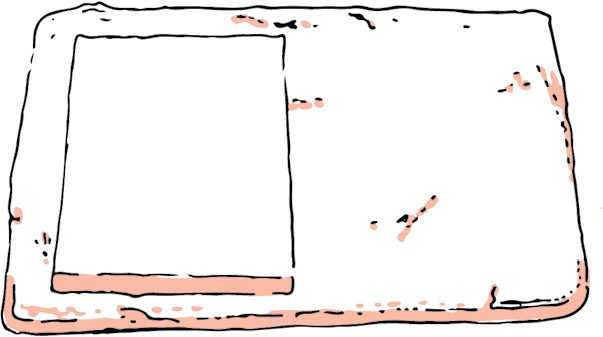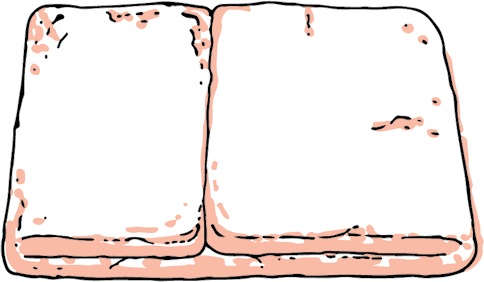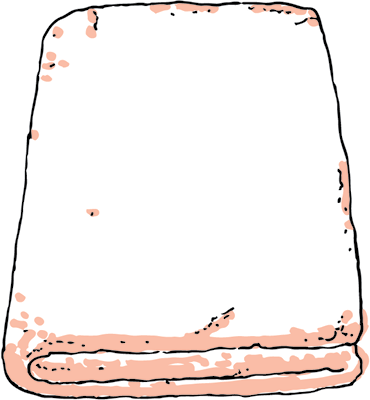Puff Pastry
Puff pastry is made using the technique of lamination, which creates gorgeous crisp, flaky layers (more about this Lamination Method). I fell in love with the process when I was working in a hotel kitchen one summer. The process is laborious but strangely calming—and the results are insanely satisfying! If you’re too intimidated to give it a go, you can use store-bought puff pastry for most of the recipes in this book that call for it, but making your own is a really fun weekend project.
Makes about 1.36 kg / 3 pounds dough
Difficulty: Hard
Make Ahead and Storage: The dough can be tightly wrapped in plastic wrap and refrigerated for up to 3 days or frozen for up to 3 months (wrap them individually); thaw overnight in the fridge.
- Butter Block
- 453 g / 1 lb unsalted butter, at room temperature
- 71 g / ⅔ cup bread flour
- Dough
- 397 g / 3⅓ cups bread flour
- 198 g / 1⅔ cups all-purpose flour
- 6 g / 1½ teaspoons fine sea salt
- 113 g / 4 oz / 8 tablespoons unsalted butter, at room temperature
- 287 g / 1 cup plus 3 tablespoons cool water
1. Make the butter block: I use a baking sheet as a visual guide when I make puff pastry and roll the dough out to slightly larger than the baking sheet, so I don’t need to use a ruler. Cut a 13-by-18-inch piece of parchment paper and place it on your work surface with one of the short ends facing you.
2. In a medium bowl, blend the butter and flour together with a wooden spoon or silicone spatula. Scoop the mixture onto the lower third of the parchment paper and use an offset spatula to spread it into a rectangle 6 by 9 inches and ½ inch thick. Use the blade of the spatula to help keep the edges squared off while you work. (See Tips for working with laminated doughs for more about forming a butter block.) Fold the upper part of the parchment down over the butter block—you can use the paper to help you square off the edges. Transfer the wrapped butter block to the refrigerator.
3. Make the dough: In the bowl of a stand mixer fitted with the dough hook, mix the bread flour, all-purpose flour, and salt to combine. Add the butter and mix on low speed until it is fully incorporated and the mixture looks a little crumbly, about 1 minute. Add the water and mix until the dough comes together, 4 minutes. Increase the speed to high and mix for 1 to 2 minutes more, until the dough is smooth.
4. Turn the dough out onto a large sheet of plastic wrap and use your hands to form it into a rough rectangular shape. Wrap tightly in the plastic and chill for 30 to 40 minutes. (This lets the dough rest and also allows it to come to a temperature and texture similar to the butter block.)
5. When the dough and the butter block are both chilled but still flexible (60° to 70°F / 16° to 21°C), it’s time to lock the butter into the dough: On a lightly floured surface, roll the dough out to a rectangle 12 by 10 inches and ⅔ inch thick. If necessary, turn the rectangle so that one of the shorter ends is facing you.
6. Peel the paper back from the top of the butter block, leaving it on the paper so that you can use it to help you to guide it onto the dough: Invert it onto the bottom half of the dough, positioning it so that there is a ½- to ¾-inch margin of dough around the sides and bottom of the butter block. Fold the top of the dough down over the butter block so that it meets the opposite edge of the dough. Press the edges of the dough together firmly all the way around to seal, then fold the excess dough at the bottom and edges under itself. You should now have a firm but pliable rectangular package of dough (about 6 by 10 inches) enveloping the butter block. If the dough and/or butter block are too soft to proceed with rolling and folding, cover the dough with plastic wrap, place it on a parchment-lined baking sheet, and chill it for about 30 minutes.
7. Line a baking sheet with parchment paper. On a lightly floured surface, roll the dough out to a rectangle 13 by 19 inches and ½ inch thick. If you’re having a hard time rolling the dough, it’s probably too cold. Let stand at room temperature for 10 to 15 minutes. On the other hand, if bits of butter are breaking through the surface and getting all melty and squishy, it’s too warm; return it to the refrigerator to firm up.
8. There are two kinds of folds used for making puff pastry: the 4-fold and the 3-fold. You will be making a 4-fold, a 3-fold, a 4-fold, and a final 3-fold. (If this sounds confusing, it will all make sense soon!) For the first 4-fold, position the dough so that one of the long sides is facing you. Fold the left edge about three quarters of the way over the dough. Fold the right edge one quarter of the way over the dough so it meets the left edge. The dough will now look somewhat like an open book with an off-center spine.
9. Fold the larger side over the shorter side. You will now have 4 layers of dough. Transfer the dough to the parchment-lined baking sheet. Brush all excess flour off the surface of the dough. Cover the baking sheet with plastic wrap and refrigerate the dough for about 30 minutes—you want the dough to relax and return to the ideal temperature.
10. Now make the first 3-fold: On a lightly floured surface, roll the chilled dough out again to a rectangle 13 by 19 inches and ½ inch thick. With one of the long sides facing you, fold the left edge one third of the way over the dough. Then do the same with the right edge, folding it one third of the way over so that it rests on top of the piece you just folded. You will now have 3 layers of dough. Brush away the excess flour. Return the dough to the baking sheet, cover, and refrigerate for another 30 minutes.
11. Repeat steps 8 and 9 to make another 4-fold. Return the dough to the baking sheet, cover, and refrigerate for about 30 minutes.
12. You’re almost done! Repeat step 10 to make another 3-fold. Return the dough to the baking sheet, cover, and refrigerate for about 30 minutes.
13. The dough is ready to be rolled and shaped as directed in the individual recipes. Or wrap the dough and refrigerate or freeze until ready to use.
✻ Why It Works
The folding (also known as “turns”) forms multiple layers of butter and dough. Then, when the heat of the oven hits the puff pastry, the moisture in the butter begins to evaporate, creating steam, which pushes the pastry upward. Lots of flaky layers are the result.
★ Pro Tips
I use a bench knife (bench scraper) to help keep the edges straight and the corners squared off as I work on a dough like this. It’s important to keep the dough as squared off as possible, because that will help the edges to meet evenly when you complete a fold. And that ensures cleaner layers in the finished puff pastry. If the edges of the finished dough are rounded, they won’t meet up, and there will be gaps in the layering.
If you’re freezing the dough, it’s great to first roll it out into three or four ½-inch-thick sheets, which are quick and easy to thaw whenever you’re ready to use them—just like the store-bought ones!

Locking in the butter

4-fold, part 1

4-fold, part 2

3-fold, part 1

3-fold, part 2